Unstable Flow Structures Present at Different Rotational Velocities of the Centrifugal Compressor
Abstract
:1. Introduction
2. Method
2.1. General Design Description
2.2. Instrumentation
3. Results and Discussion
3.1. Stationary Performance Measurements Results
3.2. Summary of Observed Pressure Oscillations
3.3. 0.28 Nominal Speed (70 Hz)
3.4. 0.38 Nominal Speed (95 Hz)
3.5. 0.44 Nominal Speed (110 Hz)
3.6. 0.48 Nominal Speed (120 Hz)
3.7. Discussion of Key Findings
4. Concluding Remarks
- The surge peak was observed in all cases, while in the lowest rotational speeds it appeared much later (75 Hz and 90 Hz). In higher speeds, the amount of energy accumulated in the plenum was sufficient to start the surge oscillations much earlier (110 Hz, 120 Hz). The effect of frequency creeping with impeller rotational speed was observed and the surge frequency changed by about 10% from 120 Hz to 70 Hz.
- Higher frequency peaks appeared in all impeller rotational speeds with much smaller amplitudes than the surge peak. The second peak was observed in the outlet and diffuser between 25.1 Hz and 25.7 Hz with amplitude growing with the impeller rotational speed. The third peak was observed in the outlet between 47.7 Hz and 52.0 Hz. The frequency was growing with the impeller rotational speed, but the amplitude was very weak in all cases. The source of this instability was in the outlet region.
- The fourth and fifth peaks were observed around 82–86 Hz. Distinguishing them was sometimes not possible and they were treated as a single structure in this analysis. The source of this peak was located in the diffuser. This peak was appearing much before the surge and presented an interesting feature of bifurcating with the valve position. The structure presented features typical of the rotating stall, but there is no proof that it represents this structure.
- In all cases, inlet recirculation was observed. This phenomenon is gaining increasing attention recently for different kinds of centrifugal compressors and turbochargers. This study shows that it is possible to observe it in the closed-type impellers. The phenomenon was also shown to appear earlier in higher impeller rotational speeds. This phenomenon has important features that make it very useful for early instability detection systems: it always appears before the surge, it is relatively clear to distinguish from other flow phenomena, its presence has been noted in various impeller types.
Author Contributions
Funding
Conflicts of Interest
References
- Bloch, H. A Practical Guide to Compressor Technology; Wiley-Interscience: Hoboken, NJ, USA, 2006; p. 560. [Google Scholar]
- Leufvén, O.; Eriksson, L. A surge and choke capable compressor flow model—Validation and extrapolation capability. Control Eng. Pract 2013, 21, 1871–1883. [Google Scholar] [CrossRef] [Green Version]
- Gravdah, J.T.l.; Egeland, O. Compressor Surge and Rotating Stall: Modeling and Control; Springer Publishing Company: New York, NY, USA, 2011. [Google Scholar]
- Emmons, H.W.; Pearson, C.E.; Grant, H.P. Compressor Surge and Stall Propagation. ASME Trans. 1955, 77, 455–469. [Google Scholar]
- Greitzer, E. Surge and rotating stall in axial flow compressors—Part I: Theoretical compression system model. J. Eng. Gas Turbines Power 1976, 98, 190–198. [Google Scholar] [CrossRef]
- Greitzer, E. Surge and rotating stall in axial flow compressors—Part II: experimental results and comparison with theory. J. Eng. Gas Turbines Power 1976, 98, 199–211. [Google Scholar] [CrossRef]
- Yoon, S.Y.; Lin, Z.; Goyne, C.; Allaire, P.E. An enhanced Greitzer compressor model with pipeline dynamics included. In Proceedings of the 2011 American Control Conference, San Francisco, CA, USA, 29 June–1 July 2011; pp. 4731–4736. [Google Scholar] [CrossRef]
- He, X.; Zheng, X. Flow instability evolution in high pressure ratio centrifugal compressor with vaned diffuser. Exp. Therm. Fluid Sci. 2018, 98, 719–730. [Google Scholar] [CrossRef]
- Guo, S.; Chen, H.; Zhu, X.; Du, Z. Numerical Simulation of Surge in Turbocharger Centrifugal Compressor: Influences of Downstream Plenum. In Proceedings of the ASME 2011 Turbo Expo: Turbine Technical Conference and Exposition, Vancouver, British Columbia, Canada, 6–10 June 2011; pp. 1897–1908. [Google Scholar] [CrossRef]
- Galindo, J.; Tiseira, A.; Navarro, R.; Tarí, D.; Meano, C.M. Effect of the inlet geometry on performance, surge margin and noise emission of an automotive turbocharger compressor. Appl. Therm. Eng. 2017, 110, 875–882. [Google Scholar] [CrossRef]
- Kabalyk, K.; Jasek, M.; Liskiewicz, G.; Horodko, L. Experimental analysis of the influence of outlet network volume and inlet guide vane positioning on surge behavior in a single-stage low-speed centrifugal compressor. Proc. Inst. Mech. Eng. Part J. Power Energy 2018, 232. [Google Scholar] [CrossRef]
- Zheng, X.; Sun, Z.; Kawakubo, T.; Tamaki, H. Experimental investigation of surge and stall in a turbocharger centrifugal compressor with a vaned diffuser. Exp. Therm. Fluid Sci. 2017, 82, 493–506. [Google Scholar] [CrossRef]
- Semlitsch, B.; Mihăescu, M. Flow phenomena leading to surge in a centrifugal compressor. Energy 2016, 103, 572–587. [Google Scholar] [CrossRef]
- Liśkiewicz, G.; Horodko, L.; Stickland, M.; Kryłłowicz, W. Identification of phenomena preceding blower surge by means of pressure spectral maps. Exp. Therm. Fluid Sci. 2014, 54, 267–278. [Google Scholar] [CrossRef]
- Day, I.J. Stall, Surge, and 75 Years of Research. J. Turbomach. 2015, 138, 011001. [Google Scholar] [CrossRef]
- Frigne, P.; van den Braembussche, R. Distinction Between Different Types of Impeller and Diffuser Rotating Stall in a Centrifugal Compressor With Vaneless Diffuser. J. Eng. Gas Turbines Power 1984, 106, 468–474. [Google Scholar] [CrossRef]
- Biliotti, D.; Bianchini, A.; Vannini, G.; Belardini, E.; Giachi, M.; Tapinassi, L.; Ferrari, L.; Ferrara, G. Analysis of the Rotordynamic Response of a Centrifugal Compressor Subject to Aerodynamic Loads due to Rotating Stall. In Proceedings of the ASME Turbo Expo 2014: Turbine Technical Conference and Exposition, Düsseldorf, Germany, 16–20 June 2014. [Google Scholar]
- Oakes, W.; Lawless, P.B. A Characterization of Rotating Stall Behaviors in High and Low Speed Centrifugal Compressors. Int. Compress. Eng. Conf. 1998, 773–778. [Google Scholar]
- Mizuki, S.; Oosawa, Y. Unsteady Flow Within Centrifugal Compressor Channels Under Rotating Stall and Surge. J. Turbomach. 1992, 114, 312–320. [Google Scholar] [CrossRef]
- Sun, Z.; Wang, B.; Zheng, X.; Kawakubo, T.; Tamaki, H.; Numakura, R. Effect of bent inlet pipe on the flow instability behavior of centrifugal compressors. Chin. J. Aeronaut. 2020. [Google Scholar] [CrossRef]
- Harley, P.; Spence, S.; Filsinger, D.; Dietrich, M.; Early, J. Meanline Modelling of Inlet Recirculation in Automotive. In Proceedings of the ASME Turbo Expo 2014: Turbine Technical Conference and Exposition, Düsseldorf, Germany, 16–20 June 2014. [Google Scholar]
- Schreiber, C. Inlet Recirculation in Radial Compressors; University of Cambridge: Cambridge, UK, 2018. [Google Scholar]
- Liu, A.X.; Zheng, X.Q. Methods of surge point judgment for compressor experiments. Exp. Therm. Fluid Sci. 2013, 51, 204–213. [Google Scholar] [CrossRef]
- Tamaki, H. Experimental Study on Surge Inception in a Centrifugal Compressor. Int. J. Fluid Mach. Syst. 2009, 2, 409–417. [Google Scholar] [CrossRef] [Green Version]
- Hagino, N.; Uda, K.; Kashiwabara, Y. Prediction and Active Control of Surge Inception of a Centrifugal Compressor. In Proceedings of the International Gas Turbine Congress, Toky, Japan, 2–7 November 2003. [Google Scholar]
- Brown, C.A.; Sawyer, S.; Oakes, W. Wavelet Based Analysis of Rotating Stall and Surge in a High Speed Centrifugal Compressor. In Proceedings of the 38th AIAA/ASME/SAE/ASEE Joint Propulsion Conference & Exhibit, Indianapolis, Indiana, 7–10 July 2002. [Google Scholar]
- Lawless, P.B.; Fleeter, S. Rotating Stall Acoustic Signature in a Low-Speed Centrifugal Compressor: Part 1—Vaneless Diffuser. J. Turbomach. 1995, 117, 87–96. [Google Scholar] [CrossRef]
- Kang, J.S.; Kang, S.H. Stall Inception in a High-Speed Centrifugal Compressor. In Proceedings of the ASME Turbo Expo 2001: Turbine Technical Conference and Exposition, New Orleans, LA, USA, 4–7 June 2001. [Google Scholar]
- Horodko, L. Identification of rotating pressure waves in a centrifugal compressor diffuser by means of the wavelet cross-correlation. Int. J. Wavelets Multiresolution Inf. Process. 2006, 4, 373–382. [Google Scholar] [CrossRef]
- Liśkiewicz, G.; Horodko, L. Time-frequency analysis of the Surge Onset in the Centrifugal Blower. Open Eng. 2015, 5, 299–306. [Google Scholar] [CrossRef]
- Sun, Z.; Zheng, X.; Kawakubo, T. Experimental investigation of instability inducement and mechanism of centrifugal compressors with vaned diffuser. Appl. Therm. Eng. 2018, 133, 464–471. [Google Scholar] [CrossRef]
- Galindo, J.; Climent, H.; Guardiola, C.; Tiseira, A. On the effect of pulsating flow on surge margin of small centrifugal compressors for automotive engines. Exp. Therm. Fluid Sci. 2009, 33, 1163–1171. [Google Scholar] [CrossRef]
- Bianchini, A.; Andreini, G.; Ferrari, L.; Rubino, D.T.; Ferrara, G. Development of a criterion for a robust identification of diffuser rotating stall onset in industrial centrifugal compressors. J. Eng. Gas Turbines Power 2018. [Google Scholar] [CrossRef]
- Liśkiewicz, G.; Sobczak, K.; Stickland, M.; Liśkiewicz, G. Numerical Study of Off-Design Centrifugal Compressor Operation and Flow Phenomena Preceding Surge. In Proceedings of the ASME Turbo Expo 2018: Turbine Technical Conference and Exposition, Oslo, Norway, 11–15 June 2018. [Google Scholar]
- Chmielecki, J.; Liśkiewicz, G.; Kryłłowicz, W. Numerical study of surge predecessors in centrifugal blower—inlet recirculation. Trans. Inst. Fluid Flow Mach. 2016, 136, 29–44. [Google Scholar]
- Zheng, X.; Liu, A. Phenomenon and Mechanism of Two-Regime-Surge in a Centrifugal Compressor. J. Turbomach. 2015, 137, 81007. [Google Scholar] [CrossRef]
- Yamaguchi, N. A Study on the Fundamental Surge Frequencies in Multi-Stage Axial Flow Compressor Systems. Int. J. Fluid Mach. Syst. 2014, 7, 160–173. [Google Scholar] [CrossRef]
- van Helvoirt, J.; de Jager, B. Dynamic model including piping acoustics of a centrifugal compression system. J. Sound Vib. 2007, 302, 361–378. [Google Scholar] [CrossRef]
- Brun, K.; Nored, M.G.; Kurz, R. Impact of Piping Impedance and Acoustic Characteristics on Centrifugal Compressor Surge and Operating Range. J. Eng. Gas Turbines Power 2014, 137, 032603. [Google Scholar] [CrossRef]
- Bianchini, A.; Biliotti, D.; Tommaso Rubino, D.; Ferrari, L.; Ferrara, G. Experimental Analysis of the Pressure Field Inside a Vaneless Diffuser From Rotating Stall Inception to Surge. J. Turbomach. 2015, 137, 111007. [Google Scholar] [CrossRef]
- Grapow, F.; Liśkiewicz, G. Three-Dimensional Vaneless Diffuser Rotating Stall Numerical Study. In Proceedings of the ASME Turbo Expo 2018: Turbine Technical Conference and Exposition, Oslo, Norway, 11–15 June 2018. [Google Scholar]
- Bianchini, A.; Biliotti, D.; Giachi, M.; Belardini, E.; Tapinassi, L.; Ferrari, L.; Ferrara, G. Some Guidelines for the Experimental Characterization of Vaneless Diffuser Rotating Stall in Stages of Industrial Centrifugal Compressors. In Proceedings of the ASME Turbo Expo 2014: Turbine Technical Conference and Exposition, Düsseldorf, Germany, 16–20 June 2014. [Google Scholar]
- Sen, M.; Breugelmans, F.A.E. Prerotation And Fluid Recirculation In The Suction Pipe Of Centrifugal Pumps. Available online: https://oaktrust.library.tamu.edu/handle/1969.1/163693 (accessed on 11 August 2020).
- Semlitsch, B.V.J.; Mihaescu, M.; Fuchs, L.; Gutmark, E.; Gancedo, M. Numerical Flow Analysis of a Centrifugal Compressor with Ported and without Ported Shroud. SAE Tech. Paper Ser. 2014. [Google Scholar] [CrossRef] [Green Version]
- Sundström, E.; Semlitsch, B.; Mihăescu, M. Acoustic signature of flow instabilities in radial compressors. J. Sound Vib. 2018, 434, 221–236. [Google Scholar] [CrossRef]
- Tamaki, H.; Zheng, X.; Zhang, Y. Experimental Investigation of High Pressure Ratio Centrifugal Compressor With Axisymmetric and Nonaxisymmetric Recirculation Device. J. Turbomach. 2013, 135. [Google Scholar] [CrossRef]
- He, X.; Zheng, X. Roles and mechanisms of casing treatment on different scales of flow instability in high pressure ratio centrifugal compressors. Aerosp. Sci. Technol. 2018. [Google Scholar] [CrossRef]
- Gancedo, M.; Gutmark, E.; Guillou, E. PIV measurements of the flow at the inlet of a turbocharger centrifugal compressor with recirculation casing treatment near the inducer. Exp. Fluids 2016, 57. [Google Scholar] [CrossRef]
- Mckee, R.J.; Carl, E.E. Method and Apparatus for Detecting the Occurrence of Surge in a Centrifugal Compressor. U.S. Patent No. 6,981,838, 3 January 2006. [Google Scholar]



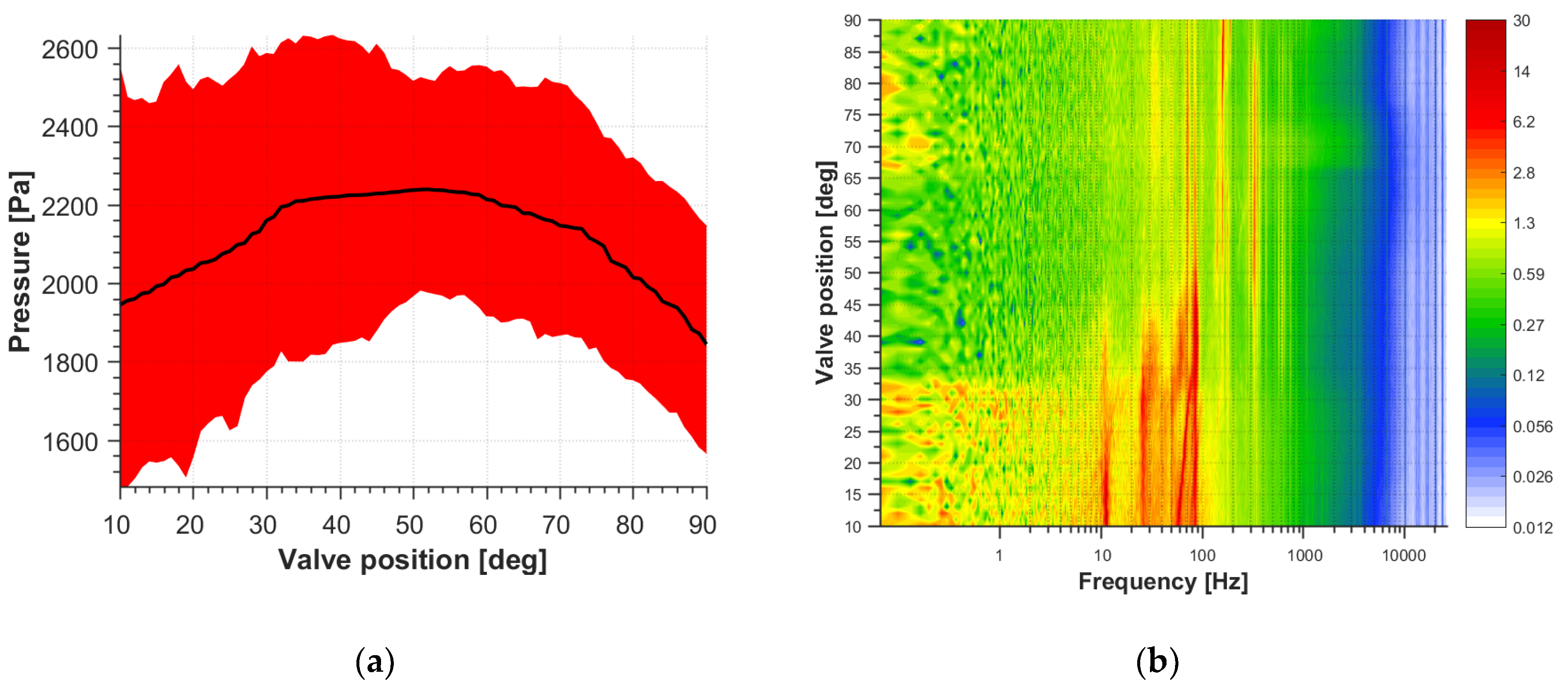
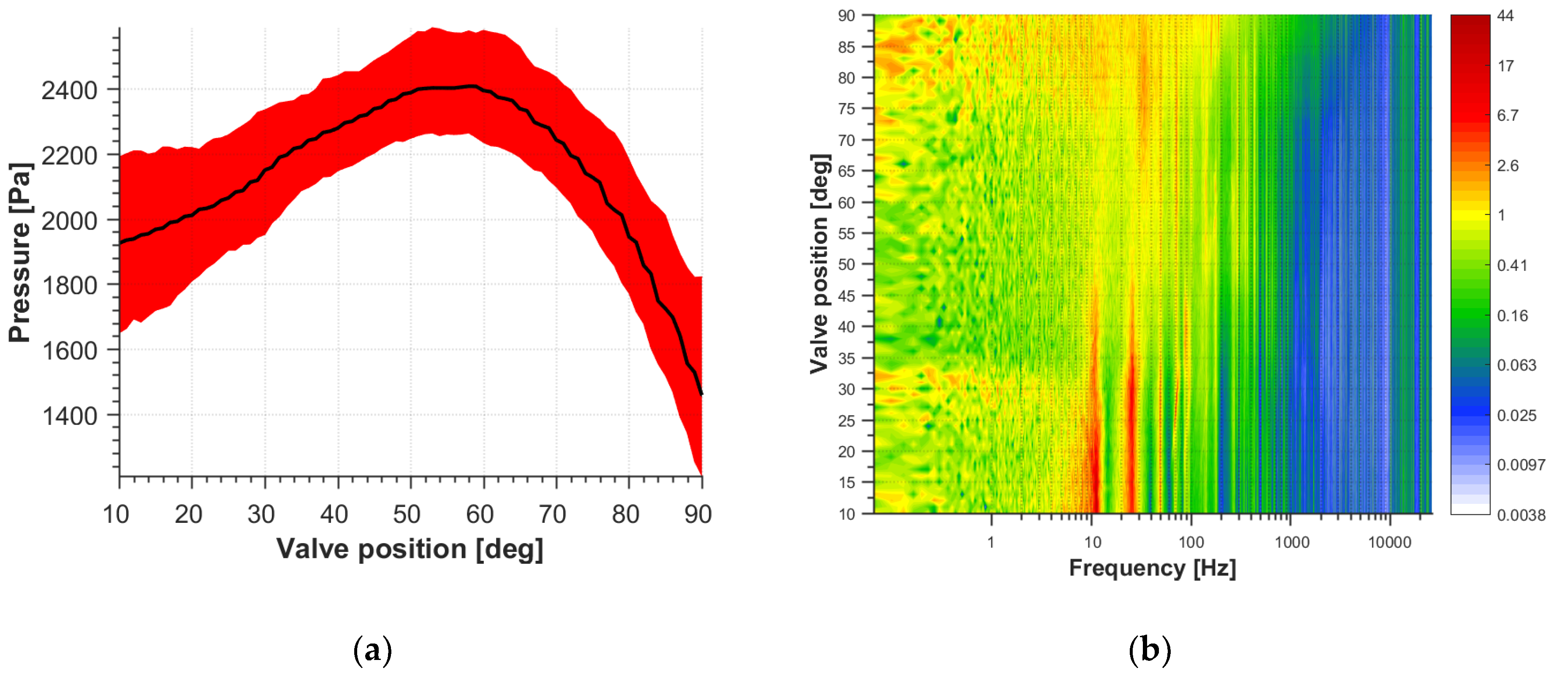


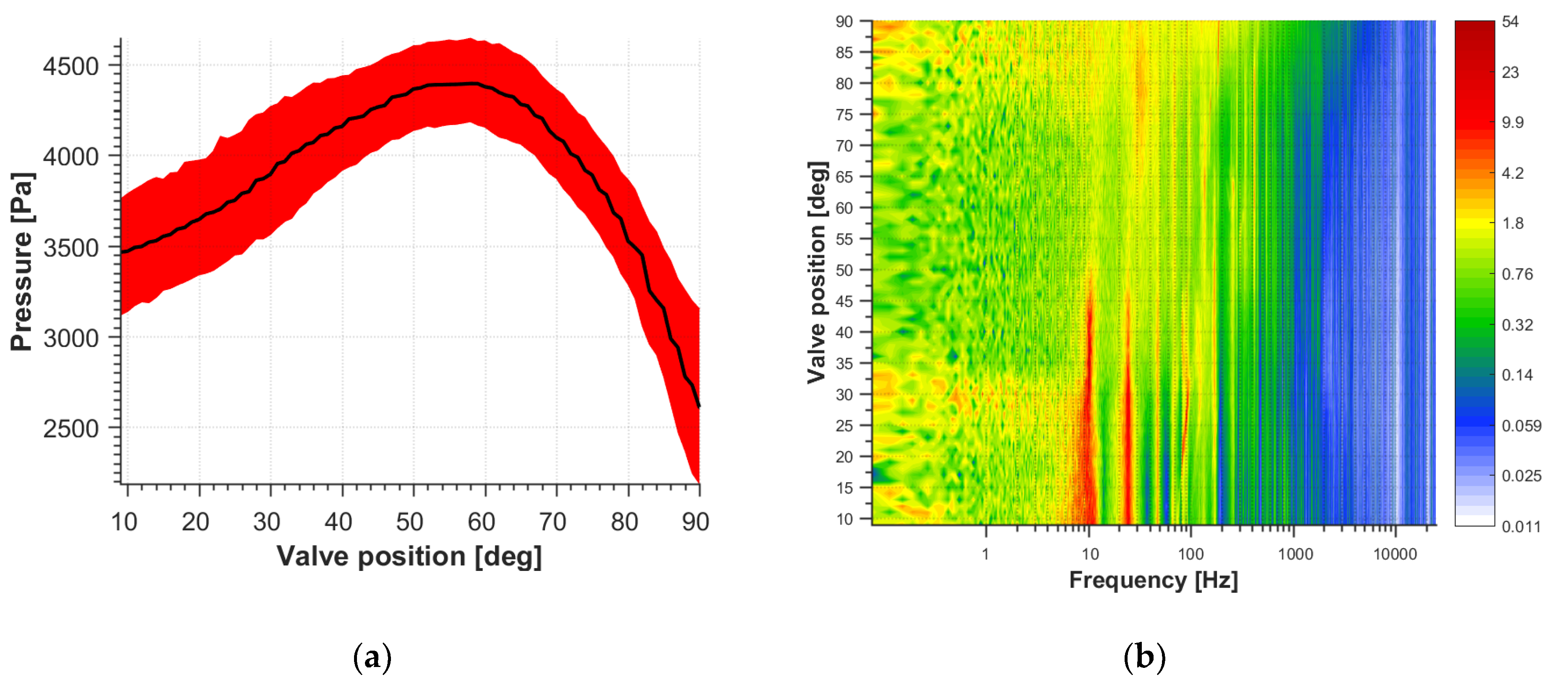
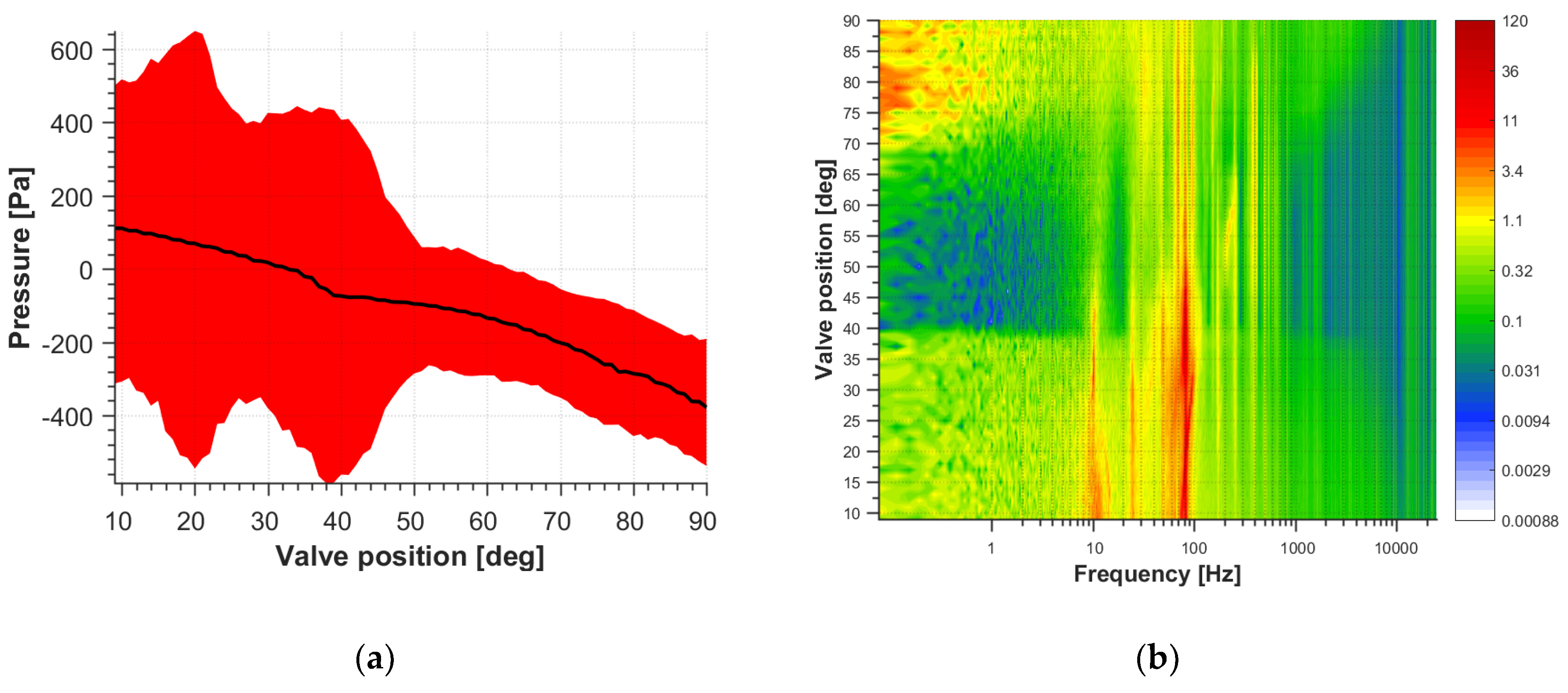
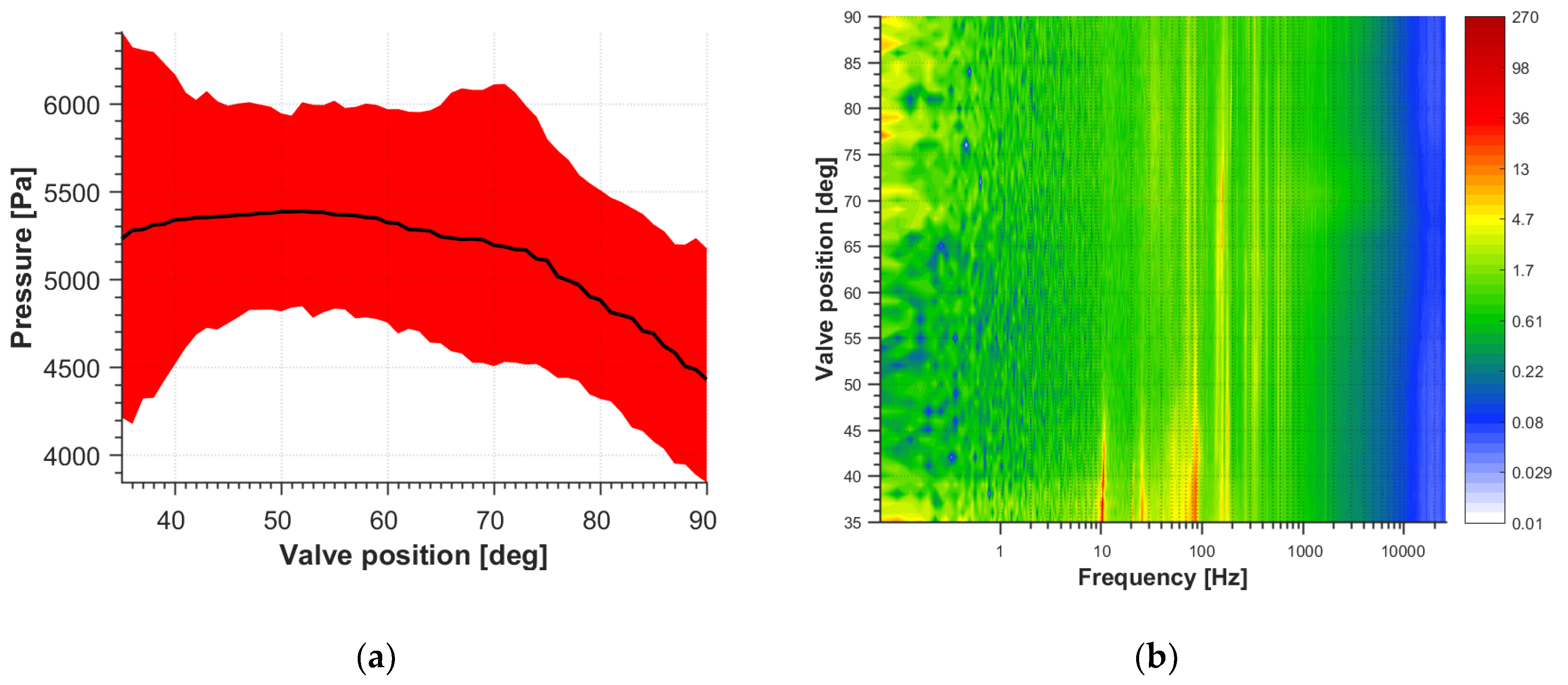

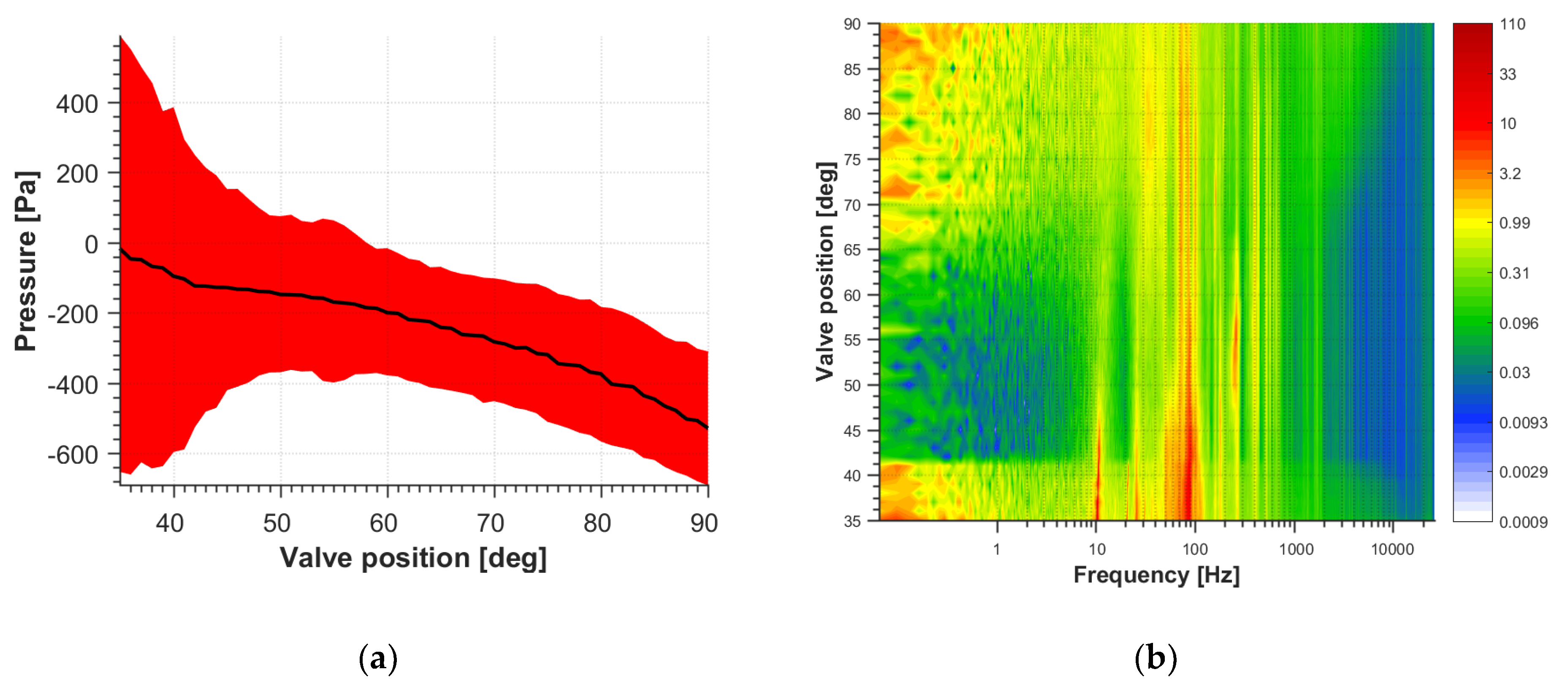


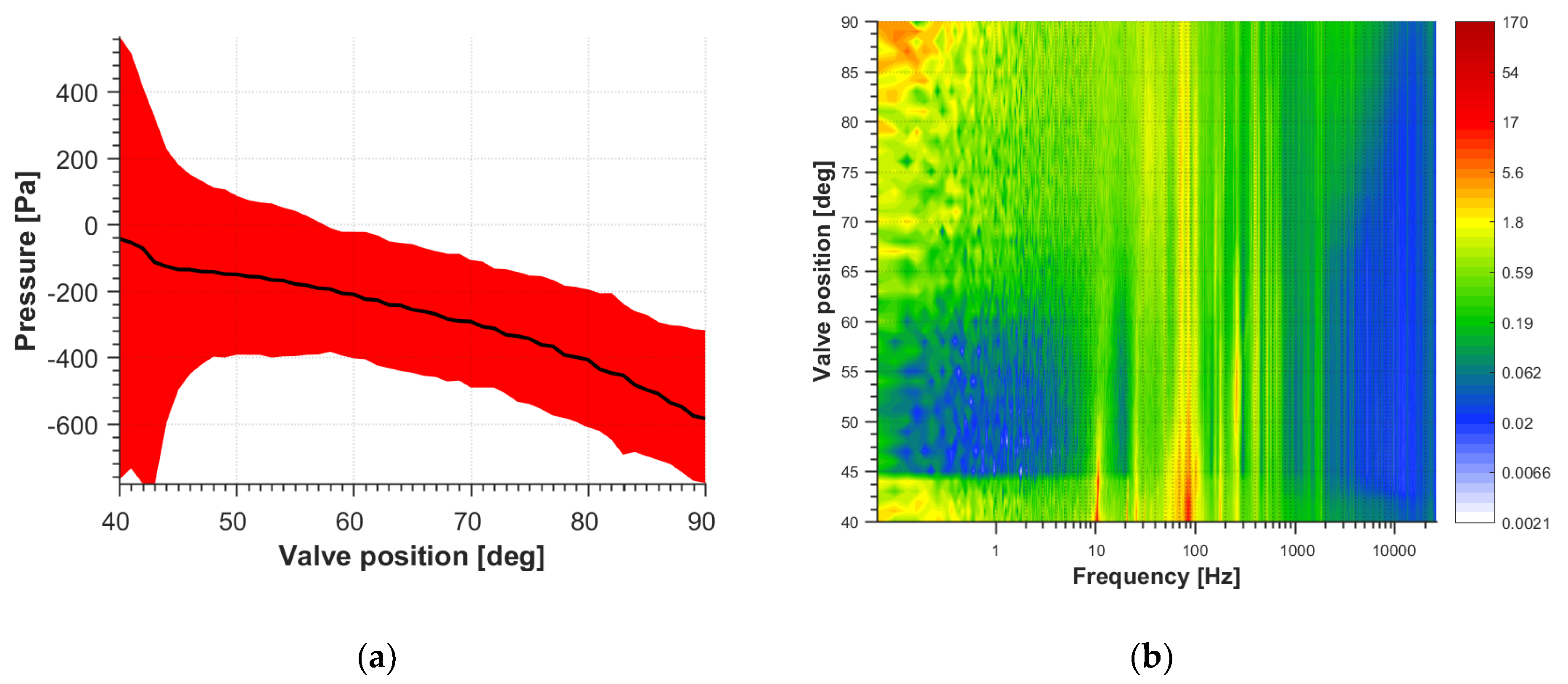
| Medium | Air |
|---|---|
| Inlet pressure | 1 bar |
| Inlet temperature | 293 K |
| Impeller eye diameter | 123 mm |
| Impeller tip diameter | 265 mm |
| Impeller outlet blade height | 13 mm |
| Number of impeller blades | 15 |
| Impeller backsweep angle (tangential) | 75 deg |
| VLD inlet diameter | 290 mm |
| VLD outlet diameter | 400 mm |
| VLD channel height | 11 mm |
| Case Analyzed | Valve Position (deg) | Mass Flowrate (kg/s) | Pressure Ratio (-) | Φ (-) | Ѱ (-) | |
|---|---|---|---|---|---|---|
| Mu = 0.168 | Valve open | 30 | 0.02 | 1.021 | 0.004 | 1019 |
| Valve closed | 90 | 0.32 | 1.015 | 0.064 | 0.732 | |
| Peak preassure | 62 | 0.12 | 1.024 | 0.024 | 1161 | |
| Mu = 0.236 | Valve open | 20 | 0.04 | 1.038 | 0.006 | 0985 |
| Valve closed | 90 | 0.44 | 1.029 | 0.064 | 0.758 | |
| Peak preassure | 56 | 0.15 | 1.045 | 0.021 | 1159 | |
| Mu = 0.288 | Valve open | 40 | 0.09 | 1.064 | 0.010 | 1014 |
| Valve closed | 90 | 0.54 | 1.045 | 0.061 | 0.726 | |
| Peak preassure | 56 | 0.19 | 1.068 | 0.021 | 1074 | |
| Rotational Speed | 120 Hz | 110 Hz | 95 Hz | 70 Hz | |
|---|---|---|---|---|---|
| First Peak | Frequency | 10.4 Hz | 10.3 Hz | 11.5 Hz | 11.2 Hz |
| Amplitude | 761 Pa (outlet) 347 Pa (diffuser) | 535 Pa (outlet) 276 Pa (diffuser) | 45 Pa (outlet) 34 (diffuser) | 31 Pa (outlet) 22 Pa (diffuser) | |
| MOA diffuser | 47 deg | 47 deg | 43 deg | 41 deg | |
| MOA outlet | 49 deg | 47 deg | 50 deg | 46 deg | |
| MOA inlet | 49 deg | 47 deg | 44 deg | 46 deg | |
| Second Peak | Frequency ** | 25.7 Hz (2.47) | 25.5 Hz (2.48) | 25.1 Hz (2.18) | 25.7 Hz (2.29) |
| Amplitude | 16 Pa (outlet) 12 Pa (diffuser) | 27 Pa (outlet) 21 (diffuser) | 13 Pa (outlet) | 8 Pa (outlet) | |
| MOA diffuser | 42 deg | 44 deg | 36 deg | 43 deg | |
| MOA outlet | 43 deg | 42 deg | 47 deg | 47 deg | |
| MOA inlet | 43 deg | 45 deg | 36 deg | 50 deg | |
| Third Peak | Frequency ** | 52.0 Hz (5.00) | 49.8 Hz (4.83) | 47.7 Hz (4.15) | 49.7 Hz (4.44) |
| Amplitude | 6 Pa (outlet) | 5 Pa (outlet) | 5 Pa (outlet) | 3 Pa (outlet) | |
| MOA diffuser | - | - | - | - | |
| MOA outlet | 37 deg | 39 deg | 40 deg | 37 deg | |
| MOA inlet | - | - | - | - | |
| Fourth Peak/Fifth Peak | Frequency ** | 84.7 Hz (8.14) | 85.8 Hz (8.33) | 82.7 Hz (7.19) | 85.6 Hz (7.64) |
| Amplitude | 22 Pa (diffuser) | 28 (diffuser) | 19 Pa (diffuser) | 11 Pa (diffuser) | |
| MOA diffuser | 43 deg | 48 deg | 56 deg | 50 deg | |
| MOA outlet | - | - | 40 deg * | 44 deg * | |
| MOA inlet | 52 deg | 60 deg | 50 deg | 50 deg | |
| Wide Spectrum Noise | Frequency | - | - | - | - |
| Amplitude | - | - | - | - | |
| MOA diffuser | - | - | 32 deg | 33 deg | |
| MOA outlet | - | - | 32 deg | 33 deg | |
| MOA inlet | 44 deg | 41 deg | 39 deg | 37 deg | |
© 2020 by the authors. Licensee MDPI, Basel, Switzerland. This article is an open access article distributed under the terms and conditions of the Creative Commons Attribution (CC BY) license (http://creativecommons.org/licenses/by/4.0/).
Share and Cite
Liśkiewicz, G.; Kabalyk, K.; Jaeschke, A.; Grapow, F.; Kulak, M.; Stajuda, M.; Kryłłowicz, W. Unstable Flow Structures Present at Different Rotational Velocities of the Centrifugal Compressor. Energies 2020, 13, 4146. https://doi.org/10.3390/en13164146
Liśkiewicz G, Kabalyk K, Jaeschke A, Grapow F, Kulak M, Stajuda M, Kryłłowicz W. Unstable Flow Structures Present at Different Rotational Velocities of the Centrifugal Compressor. Energies. 2020; 13(16):4146. https://doi.org/10.3390/en13164146
Chicago/Turabian StyleLiśkiewicz, Grzegorz, Kirill Kabalyk, Andrzej Jaeschke, Filip Grapow, Michał Kulak, Mateusz Stajuda, and Władysław Kryłłowicz. 2020. "Unstable Flow Structures Present at Different Rotational Velocities of the Centrifugal Compressor" Energies 13, no. 16: 4146. https://doi.org/10.3390/en13164146







